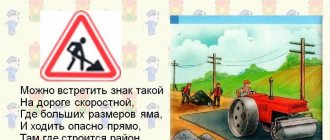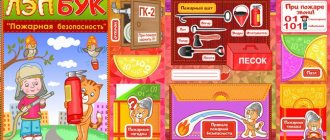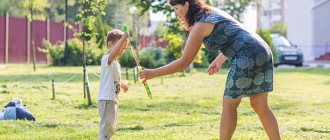Dear parents!
Every year, on the roads of our city, children fall under the wheels of cars, many of them are injured and become disabled.
But the worst thing is the death of children on the roads. Children, due to their age, are not always able to correctly assess the road situation and recognize danger. Do everything necessary so that trouble does not come to your family.
Timely teach children the ability to navigate traffic situations, cultivate the need to be disciplined on the street, careful and prudent! Remember, if you break the Rules, your child will do the same!
Teach your children the rules for safely crossing the road!
Discuss together the safest routes to travel, remind your child every day: BEFORE CROSSING THE ROAD, MAKE SURE IT IS SAFE!
Explain to your child that stopping the car right away is impossible!
Prohibit children from crossing the road because of stopped vehicles - it is life-threatening!
Learn to anticipate hidden dangers!
Discuss the safest routes together!
Dear parents! Usually you are busy with your own affairs, you have a lot of troubles, you always lack time. And yet, despite your worries, your eternal rush, remember about those who need your help, advice, your care - children and teenagers.
Dedicate a separate walk to the rules of crossing the road, check whether your child understands them correctly, and whether he knows how to use this knowledge in real traffic situations. To do this, practice crossing a pedestrian crossing together through a one-way and two-way roadway, through controlled and unregulated intersections.
Walk with your child along the usual route to and from school. Talk about why it is important to walk the same path. Draw your child’s attention to all the dangers and hidden “traps” that may lie in wait for him along the way, think over the route so that it becomes safer.
Before making a child’s dream come true and purchasing a bicycle (moped or scooter), parents should pay attention to the area where they live and make sure there are safe places - bike paths, a stadium, a park or a schoolyard. While allowing children to be restless, it is worth considering that at any moment he can leave his yard and go to a friend or classmate in the next block. Finding yourself on the roadway in a stream of vehicles, it is difficult for even a trained person to navigate in the first minutes of movement, but what can be said about a child who needs to simultaneously work with his legs, hold the steering wheel with his hands, control the situation around him and remember to follow safety measures. In response to any change in the road situation, in the absence of experience and skills, a child may become confused, begin to panic and act inappropriately. We should not forget that a bicycle is one of the most unstable and unprotected vehicles, and even minor collisions can have very serious consequences.
If your child is under 12 years old, he or she is not allowed to ride in the front passenger seat of a car; the safest place in the car is behind the driver.
During the holidays, it doesn't matter whether your child stays in the city or leaves. It is necessary to use every opportunity to remind him of the rules of the road. Do not leave children unattended on the street, do not allow them to play near the roadway.
Teach children to follow traffic rules from an early age. And don’t forget that personal example is the most intelligible form of learning.
SELF-BREAKING PARENTS FROM THE PROBLEM OF CHILDHOOD ROAD INJURIES IS A DIRECT ROAD TO TRAGEDY IN YOUR FAMILY.
Memo
for parents on teaching children
traffic rules
Take your time, cross the road at a measured pace. When going out onto the road, stop talking - the child must get used to the fact that when crossing the road you need to concentrate.
Do not cross the road at a red or yellow traffic light, no matter how much you are in a hurry. Cross the road only in places marked with the “Pedestrian Crossing” road sign. Get off the bus, trolleybus, taxi first. Otherwise, the child may fall or run onto the roadway.
Invite your child to participate in your observations of the situation on the road, show him those cars that are preparing to turn, driving at high speed, etc.
Do not leave with your child from behind bushes or a car without first inspecting the road; this is a typical mistake and children should not be allowed to repeat it.
Do not allow children to play near the road or on the carriageway.
Memo for parents on traffic rules
- It is necessary to teach children not only to follow the traffic rules, but also from a very early age to teach them to observe and navigate. It must be taken into account that the main way to develop behavioral skills is through observation and imitation of adults, especially parents. Many parents, without understanding this, teach their children incorrect behavior by personal example.
- When you are on the roadway with your child, do not rush, cross the road at a measured pace.
- Do not send your child to cross or cross the road in front of you - by doing this you are teaching him to cross the road without looking both ways. A small child must be held tightly by the hand and be prepared to hold it when trying to escape - this is a typical cause of accidents.
- Teach your child to look. The child must develop a solid skill: before taking the first step from the sidewalk, he turns his head and examines the road in all directions. This should be brought to automaticity.
- Teach your child to notice a car. Sometimes a child does not notice a car or motorcycle from afar. Teach him to peer into the distance.
- Teach your child to estimate the speed and direction of the future movement of the car. Teach your child to determine which car is going straight and which is preparing to turn.
- Firmly understand and teach your child that you can enter and exit any type of transport only when it has completely stopped. Explain to your child why you can’t jump while walking.
TRAFFIC DEPARTMENT of the Internal Affairs Directorate for the city of Bryansk
It's a shame if you can't see it
Parents should ensure that their child’s clothing has any reflective elements. This is especially important right now, when it gets dark early, but snow has not yet fallen everywhere. Practical mothers try to dress their children in something darker that is less likely to get dirty. If you do this and there are no reflective elements on your child’s clothes, buy for him at least a few cheap flickers that can be sewn, glued, or hung on a jacket or backpack. By the way, it doesn’t hurt for adults to acquire similar accessories either. And wearing them shouldn't be a shame.
Recommendations for parents.
The main danger is a stationary car.
Why? Yes, because having seen the approaching car in advance, the pedestrian will give way to it. A stationary car deceives: it can block a moving one and prevent you from noticing the danger in time.
You cannot go out onto the road because of parked cars. As a last resort, you need to carefully look out from behind a standing car, make sure that there is no danger, and only then cross the street. Watch with your child the cars standing at the edge of the roadway and draw your child’s attention to the moment when another one suddenly appears from behind the standing car. Draw your child's attention to the fact that a bus standing at a stop also makes it difficult to see the car moving behind it.
Do not go around a stationary bus, either in front or behind!
A stationary bus, no matter how you walk around it - in front or behind, covers a section of the road along which a car can pass at the moment when you decide to cross it. In addition, people near the bus stop are usually in a hurry and forget about safety.
You need to wait until the bus leaves, or, when crossing the road, move as far away from it as possible.
Know how to anticipate hidden dangers!
Due to some obstacle (a house, a parked car, a fence, bushes, etc.) that prevents you from seeing the entire road, a car may unexpectedly leave.
To cross the road, you need to choose a place where nothing will prevent you from inspecting it. As a last resort, you can carefully look out from behind the obstacle, make sure that there is no danger, and only then cross the street.
The car approaches slowly. And yet - you have to skip it!
A slow moving car can hide behind a car going at high speed. A child often does not suspect that another car may be hidden behind one car.
And at the traffic lights you can meet danger!
Children often reason like this: “The cars are still standing, the drivers see me and will let me through.” They are wrong. Immediately after turning on the green signal for drivers, a car that was not visible behind the standing cars and whose driver cannot see the pedestrian may enter the crossing. If the green traffic light for pedestrians goes out, you need to stop
Today, on city streets, we are constantly faced with car drivers violating traffic rules: driving at prohibitively high speeds, ignoring traffic lights and crossing signs. Therefore, it is not enough to teach children to focus only on a green traffic light. When crossing the street, the child must not only wait for the right light, but also make sure that all the cars have stopped.
Children often run across a “deserted” street without looking.
On the street, where cars rarely appear, children are not afraid of them; they run out onto the road without first inspecting it and get hit by a car.
Always develop the habit in your child before going out onto the road, even if there are no cars on it, to stop, look around, listen - and only then cross the street.
When standing on the center line, remember: there may be a car behind you!
Once they reach the center line and stop, children usually only pay attention to the cars approaching them from the right and forget about the cars passing behind them. Frightened, the child may take a step back - right under the wheels of a car approaching him from the left.
If you had to stop in the middle of the street, you need to be extremely focused, not make a single movement without looking around, and watch out for cars approaching you from the right and left.
On the street, know how to hold your child’s hand tightly!
Being next to an adult, the child relies on him and either does not watch the road at all or watches poorly. An adult does not take this into account.
Children, not noticing the coming car and thinking that the way is clear, break out of the adult’s hands, run across the road and fall under the wheels of the car. Near the crossing, you must hold the child's hand so that he cannot escape.
Simple safety rules when traveling by car
– Children under 12 years of age must sit in the back seat of the car unless there is a special child restraint in the front seat.
– All safety devices must be correctly selected according to the age of the child. It is very important to ensure that your child is properly restrained for their size and weight.
– For children under 2 years of age there is a special seat that is attached to the back seat and faces the rear window. In the event of an accident, it reduces the load on the child’s neck (the most vulnerable spot in a collision) by 90%.
– For children from 3 to 8 years old, it is recommended to use a child seat with a special seat belt system. It reduces the possibility of injury by 70%. If your vehicle is equipped with an airbag, never install a child seat in the front seat.
– For children 9–12 years of age, it is recommended to use a booster seat or adapter that elevates the child's body so that the seat belt fits correctly and securely, protecting them, across the chest and down through the hips (not across the neck and abdomen). The closer the belt sits to the body, the better the protection.
– Wear your seat belts, even if your vehicle is equipped with air bags. By wearing seat belts, you reduce the risk of fatal accidents by 45%.
– A head-on collision at a speed of 50 km/h is equivalent to falling from the third floor of a building. Therefore, by not fastening your child with seat belts, you seem to be allowing him to play on the balcony without railings!
– Teach your children good habits and make them feel responsible. Explain to them how to behave and set a good example.






